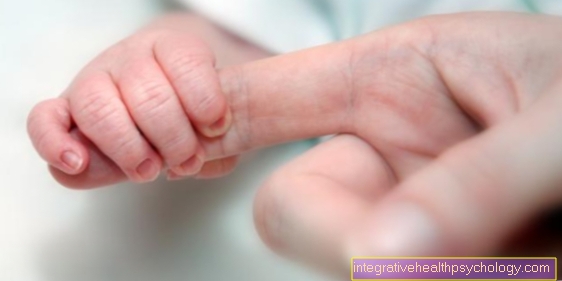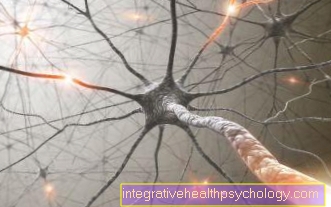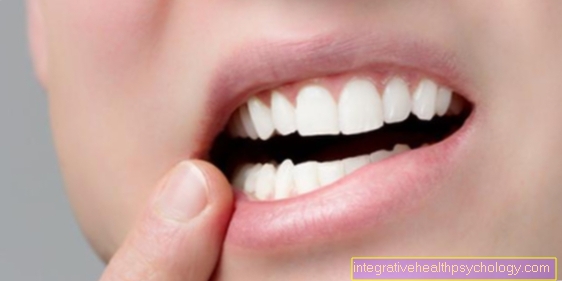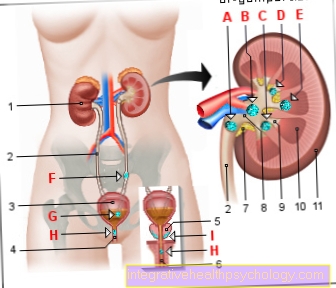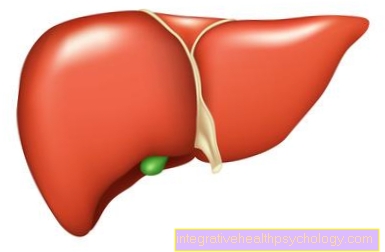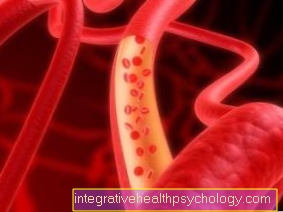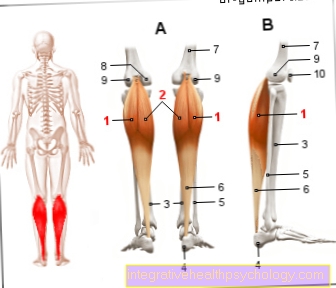Epidural lipomatosis
Definition - What is Epidural Lipomatosis?
Epidural lipomatosis is a tumor-like, diffuse increase in fat cells in the epidural space of the vertebral acid.
The epidural space, also called epidural space, is a space in the area of the spinal cord membranes. It is located between the periosteum of the spinal canal (Periosteal stratum) and the skin of the spinal cord, the so-called dura mater.
This epidural space is filled by connective and fatty tissue and contains venous vascular plexuses. In adults it ends at the level of the second sacral vertebra.
The lipomatosis of the epidural space results from the transformation of the connective tissue producing cells (Fibrocytes) into adipose tissue-producing cells (Lipocytes). Epidural lipomatosis, also known as spinal lipomatosis, is a very rare disease whose prevalence (Occurrence in humanity) is unknown.
You can read more about this topic under: Lipomatosis
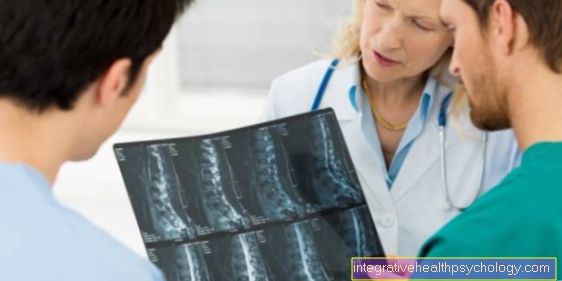
Causes of Epidural Lipomatosis
Epidural lipomatosis can have different causes. It often occurs idiopathically, that is, without an apparent cause.
Furthermore, a connection between obesity (Obesity) and various previous illnesses. These include above all diabetes mellitus and diseases in which there is a steroid excess. These are conditions in which more cortisone-like hormones are released.
Endocrine causes include diseases in which the body increasingly releases these cortisone-like hormones. A possible cause for this is a paraneoplastic ACTH secretion. The term paraneoplastic means that the hormones are formed as part of a tumor disease. The ACTH hormone promotes the production of cortisone-like hormones.
Furthermore, epidural lipomatosis was also observed increasingly in patients after an organ transplant. This is because afterwards so-called corticosteroids are usually administered to dampen the immune system. This high dose of corticosteroids also leads to a steroid excess.
Diagnosis of epidural lipomatosis
The diagnosis of spinal epidural lipomatosis is made by looking at the patient's symptoms and complaints, possible triggering factors and the results of the examination.
Pain, sensory disorders and motor disorders can indicate epidural lipomatosis, which can then be further narrowed down through targeted examinations. An increase in epidural fat tissue can then be determined in an imaging of the spine. The MRI examination is particularly suitable for this.
Furthermore, a change in the nerve conduction velocity and abnormalities in the examination of the reflexes can be found in some patients.
MRI of the spine
The MRI examination is one of the imaging procedures that do not involve any radiation exposure. Soft tissues such as connective and adipose tissue, but also muscles, can be assessed very well in the MRI, which is why it is the method of choice in the case of epidural lipomatosis.
Depending on the type of MRI scan, the fatty tissue can appear very light. One speaks of hyperintensity in the MRI.
In epidural lipomatosis, there is a hyperintense increase in adipose tissue in the epidural space of the spinal cord. This proliferation is not encapsulated, unlike, for example, a lipoma. Depending on the extent of the proliferation, a narrowing of the spinal cord or the outgoing spinal nerves can also be seen.
Read more about this topic under: MRI of the spine
Epidural lipomatosis has these symptoms
Epidural lipomatosis causes symptoms when there is a displacement and constriction of the spinal nerves or the spinal cord. This can cause various symptoms, most of which include sensory disturbances, pain and motor impairments.
The symptoms can be similar to those of a herniated disc, which also leads to constrictions in the spinal cord and spinal nerves. Depending on the level of constriction, different supply areas of the spinal cord and nerves are affected, so that, for example, sensory disorders in the arms, legs or other parts of the body can result.
So-called vegetative disorders, such as incontinence, can also arise. The symptoms are difficult to differentiate from other causes, such as a herniated disc or diabetic neuropathy, which is why epidural lipomatosis should always be considered as a differential diagnosis in the case of indicative causes.
That could also be of interest to you: Herniated Disc - Causes, Symptoms & Therapy
Treatment of epidural lipomatosis
Epidural lipomatosis can be treated with surgical decompression. This means that the excess fatty tissue is surgically removed. This removes the constriction in the area of the spinal cord and spinal nerves and the symptoms improve.
Furthermore, possible triggers of epidural lipomatosis should also be eliminated, insofar as this is possible. This can be, for example, a cortisone-producing tumor or a high-dose cortisone therapy.
Since the risk of epidural lipomatosis is greatly increased if people are overweight, weight reduction should also be sought. When stopping cortisone medication, a risk-benefit assessment should always be made. If the medication is withdrawn, it is always tapered and never withdrawn suddenly.
Would you like to lose weight and are you looking for helpful information? What should a breakfast look like while losing weight and much more can be found at: Lose weight by changing your diet
When do you need an operation?
Epidural lipomatosis is similar to a herniated disc. Surgery should be performed if the benefits outweigh any risks of an operation near the spinal cord.
An absolute indication for surgery is for paralysis and bladder and rectal disorders.
Read more on the subject below: Surgery for spinal stenosis
The course of the disease in epidural lipomatosis
If left untreated, epidural lipomatosis can progress further. Therefore, the elimination of causal factors such as obesity or steroid therapy should always be sought.
Surgical decompression is necessary in the case of severe progression and symptoms of paralysis. After this, however, epidural lipomatosis can recur. However, there is also the possibility of relapse-free.
Recommendations from the editorial team
Other topics may also be of interest to you:
- Lipomatosis
- Spinal stenosis
- Therapy of spinal stenosis
- How can you recognize a herniated disc?
- Tips on how to best lose weight





